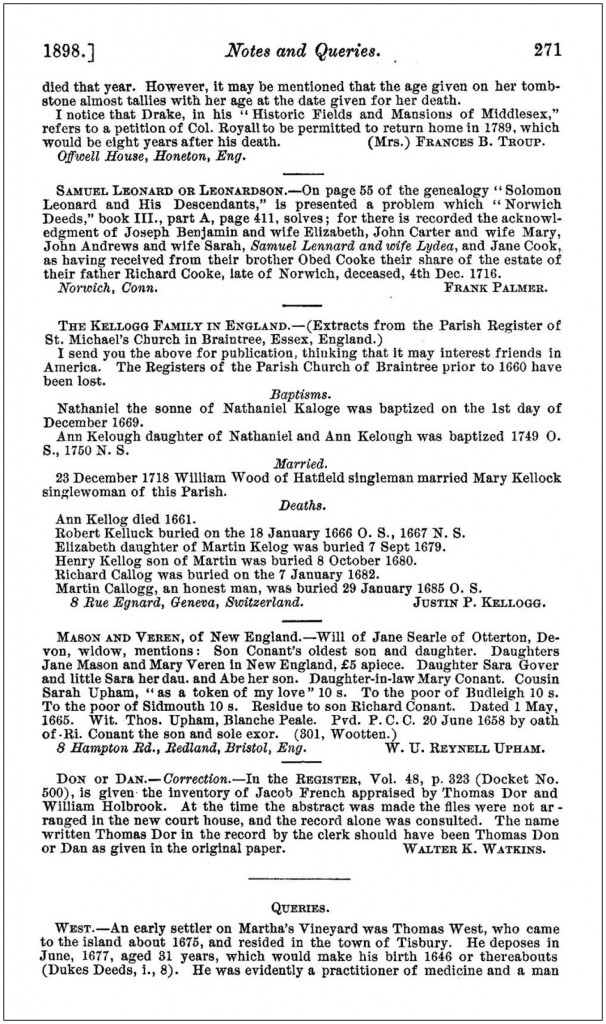
My father, the MIT graduate, used to try to tutor me in math. His most frequent frustration was getting me to remember to “read the problem.” All the answers were there, he claimed, if I understood the problem. Alas, I never conquered math, but the advice is applicable to genealogy.
When I was writing the Early New England Families sketch on Hilliard Veren, whose wife, Mary, was remembered in the will of her mother, Jane (Slade) (Conant) Searle, I cited the abstract of the will published in The New England Historical and Genealogical Register 52 (1898):271 (at left), which gives the date of the will as 1 May 1665. Apparently, I neglected to read the entire abstract and note that the date of probate was given as 20 June 1658.
In the case of Mary (Conant) Veren, the 1665 date for her mother’s will did not raise a red flag, since she lived well beyond that date, but the flags came out with her sister, Jane (Conant) (Holgrave) Mason, wife first of Joshua Holgrave and second of Elias Mason. Jane Searle’s will left a bequest to her daughter Jane Mason in New England, but Jane Mason died in 1661.
The temptation might be to conclude that the mother, in England, did not know her daughter had died four years before she wrote her will, but that type of assumption is always dangerous. Remembering Dad’s advice, I went back to the item in the Register and this time read all of it.
With some further diligence, I found the full transcript of Jane Searle’s will in Essex Institute Historical Collections, 52 (1916):51, which gives the year of her will as 1655, and the date it was proved as 29 June 1655.
Next, undoubtedly influenced by current news and my father’s admiration for Ronald Reagan, I remembered the president’s quote, “Trust, but verify.” The failure to read the whole problem was mine, but the fact that the source was published in the Register undoubtedly encouraged my omission. The Register’s 169 years of publication is renowned for its excellence, but, of course, that doesn’t mean it is, or ever has been, perfect. Does that mean we can trust nothing, even in a “trusted” source, and have to verify everything from scratch?
To be continued.
When said trusted source smacks you upside the head with the 2 x 4 of a will WRITTEN eight years AFTER it was probated, you have no choice but verify it all over again. And, of course, what you found was the error was more profound than that. (I certainly can write a 5 to appear as an 8 in my notes!)
Otherwise Trust, and Move On to The Next Issue.
Editors make mistakes, proofreaders make corrections, and then the corrections are uncorrected somehow between approved draft and printing. Heck, I’m finding between 2 and 8 obvious errors in each issue of the Register, and that’s just words or phrasing. The process is peopled by — people! Cultivating The Critical Eye is the POINT of humanistic, liberal arts training.
Cultivate, cultivate, cultivate.
P.S. Here’s a similar problem I’m reviewing right now: CT Cemetery Inscriptions, as typed up, indicate Mrs. Rebecca (Baggs) Colton died in Hartford in 1834. The contemporary several newspapers which carried her death notice are all dated 1831. They are, of course, abstracted too. I’m not jetting to Hartford to see if her stone is still standing. The best I can do is find someone to actually eyeball the newspapers (at Am. Antig. Mus. for instance) to confirm what I suspect–the CT Cemetery Inscriptions derive from 1 handwritten source which was wrong to begin with or misinterpreted in the first “translation” by the typist. I say this as the recorded deaths in the newspapers around her name are virtually the same, and the month is always the same.
I’m going with the multiple consistent contemporary sources, i.e. the newspapers, so its 1831. And, of course, am explaining all this in a footnote.
Bob, Ah, you’ve answered a question about why we genealogists keep digging — we’ve been smacked upside the head more than once!
Mike Ross gets the “eagle eye” award. Anybody else notice that President Reagan’s name was misspelled? I claim the excuse that I’m usually writing these things at 4 a.m. Everybody else must be too young to remember. Also, I am informed the quote should be “Trust, but verify” (don’t forget the comma). Thanks Mike.
Fortunately with blog posts, we can easily make these corrections!
Leslie, yes, and with “live” databases, we can upload the corrections there, too. Definitely a better system.
Leslie, forgot to say thanks.